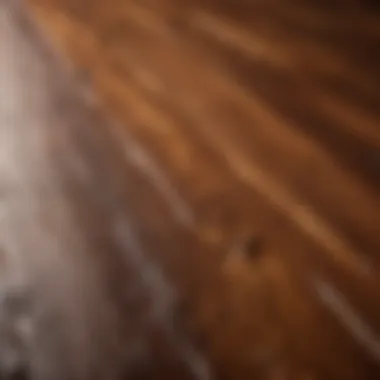Materials:
-
Wood Putty: Make sure to choose a high-quality stainable wood putty to ensure a seamless finish. Measure the amount needed based on the size of the gaps or imperfections you need to fill.
-
Stain: Select a stain that complements the wood you are working with. This will help the wood putty blend in perfectly with the surrounding surface.
-
Sandpaper: Prepare sandpaper in various grits to smoothen the surface after applying the wood putty.
-
Putty Knife: A putty knife is essential for applying the wood putty evenly and smoothly.
DIY Steps:
-
Prepare the Area: Start by cleaning the surface where the wood putty will be applied. Ensure it is free from debris and dust for better adhesion.
-
Apply the Wood Putty: Using the putty knife, scoop up a small amount of wood putty and press it into the gaps or holes that need filling. Ensure you overfill slightly to account for shrinkage.
-
Smooth the Surface: Once the wood putty is in place, use the putty knife or your fingers to smoothen the surface and remove excess putty.
-
Let it Dry: Allow the wood putty to dry completely as per the manufacturer's instructions. This is crucial for a durable and long-lasting finish.
Technical Aspects:
-
Timing: Be mindful of the drying time specified by the wood putty manufacturer. Rushing this step can lead to cracks or poor adhesion.
-
Tools: Along with the putty knife, have a damp cloth handy for cleaning up any excess putty before it dries.
-
Techniques: When applying the wood putty, work in small sections to ensure even coverage and smoother results.
DIY Project Process:


-
Sand the Surface: After the wood putty has dried, sand the area gently with fine-grit sandpaper to level the surface with the surrounding wood.
-
Apply Stain: Once the surface is smooth, apply the stain evenly with a brush or cloth. Allow the stain to penetrate and dry according to the manufacturer's instructions.
-
Finish and Enjoy: Once the stain has dried, admire your handiwork. The wood putty should now blend seamlessly with the stained wood, providing a flawless finish.
Troubleshooting Tips:


-
Cracking: If the wood putty cracks after drying, sand it down, reapply a thin layer, and follow the drying instructions meticulously.
-
Color Mismatch: In case the stained wood putty does not match the surrounding wood, consider restaining the area or blending different stains for a better match.
This detailed guide ensures that you achieve a professional finish when using stainable wood putty in your woodworking projects.
Introduction


In this article, we delve into the versatile application of wood putty that is stainable. Understanding the nuances of using stainable wood putty is essential for achieving flawless finishes in woodworking projects. Whether you are a seasoned woodworker or a DIY enthusiast, mastering the art of utilizing stainable wood putty can elevate your woodworking game.
Understanding Wood Putty
Composition of Wood Putty
When discussing wood putty, understanding its composition is crucial. Wood putty typically consists of a mixture of wood dust and a binding agent, such as epoxy or cellulose. This formulation allows the putty to mimic the look and feel of wood while providing a seamless finish. The key characteristic of wood putty composition lies in its ability to fill gaps and cracks seamlessly, enhancing the overall appearance of the woodwork. However, one consideration to keep in mind is that the composition may vary based on the specific brand or type of wood putty used.
Types of Wood Putty
Wood putty comes in various types, including oil-based, water-based, and latex-based options. Each type offers unique characteristics that cater to different woodworking needs. Oil-based putties are known for their durability and flexibility, making them ideal for outdoor projects. Water-based putties are easy to clean up and have low odor levels, suitable for indoor use. Latex-based putties are preferred for their quick drying time, making them convenient for quick fixes. Understanding the types of wood putty available allows woodworkers to choose the most suitable option based on their project requirements.
Importance of Stainable Wood Putty
Stainable wood putty plays a vital role in woodworking projects, especially when seamless color matching is desired. The ability of stainable wood putty to absorb wood stain allows for consistent color blending with the surrounding wood, resulting in a professional-looking finish. Additionally, stainable wood putty enhances the aesthetics of the woodwork by filling imperfections and achieving a smooth surface. Its stainable nature ensures that the putty seamlessly integrates with the wood, providing a natural look that lasts over time.
Benefits of Stainable Wood Putty
Seamless Color Matching
Seamless color matching is a significant advantage of using stainable wood putty. By choosing a stainable option, woodworkers can precisely match the color of the putty with the surrounding wood, creating a seamless and cohesive look that conceals imperfections effectively. This color-matching capability is particularly advantageous for intricate projects where attention to detail is paramount.
Enhanced Aesthetics
The application of stainable wood putty enhances the aesthetics of woodworking projects by ensuring a flawless finish. Whether filling nail holes, cracks, or gaps, stainable wood putty provides a seamless surface that complements the natural beauty of wood. Its ability to blend seamlessly with wood stain amplifies the overall appeal of the woodwork, elevating its visual impact.
Durability and Longevity
Apart from its aesthetic benefits, stainable wood putty offers durability and longevity to woodworking projects. Once applied and sealed properly, stainable wood putty acts as a protective barrier against moisture, preventing wood damage and preserving the integrity of the craftsmanship. Its durable properties ensure that the woodwork remains intact and retains its polished appearance over time.
Application Techniques
Wood putty that can be stained requires precise application techniques to ensure a seamless finish that blends flawlessly with the surrounding wood. The application process is crucial for achieving professional-looking results and enhancing the aesthetics of your woodworking project. By mastering the application techniques outlined in this section, you can elevate the quality of your work and achieve a durable and long-lasting outcome. Attention to detail and proper execution of the application methods are essential for seamlessly incorporating stainable wood putty into your woodworking projects.
Surface Preparation
Prior to applying stainable wood putty, thorough surface preparation is imperative to ensure optimal adhesion and a smooth finish. Cleaning and sanding the surface are fundamental steps that prepare the wood for putty application. Cleaning removes any dirt, debris, or oils that may inhibit adhesion, while sanding creates a rough surface for the putty to grip onto effectively. These steps are essential in achieving a clean and durable wood surface for the putty to adhere to, ultimately enhancing the longevity of the final finish.
Priming the surface further enhances the adhesion of the wood putty and promotes a seamless finish. Primers provide a bonding layer between the wood surface and the putty, ensuring optimal adhesion and preventing the putty from flaking or peeling over time. Choosing the right primer for your wood type is crucial, as it can impact the durability and longevity of the finished result. Proper priming sets the foundation for a flawless application of stainable wood putty.
Applying Stainable Wood Putty
When applying stainable wood putty, mastering techniques for filling gaps is essential for achieving a uniform and seamless finish. These techniques involve properly filling in gaps, cracks, and imperfections in the wood surface to create a level foundation for staining. Attention to detail and precision in filling gaps ensure a seamless transition between the wood surface and the putty, resulting in a natural and cohesive appearance.
Smoothing and shaping the putty are crucial steps that contribute to the overall aesthetics of the finished surface. Properly smoothing and shaping the putty allow for a seamless integration with the surrounding wood, giving the appearance of a continuous surface. Attention to detail in these steps ensures that the putty blends seamlessly with the wood grain, creating a professional-looking finish that enhances the overall appearance of the woodworking project.
Staining Process
Selecting the right stain is a critical aspect of the staining process when working with stainable wood putty. Choosing the right stain involves considering factors such as the wood type, desired color, and compatibility with the putty. The stain chosen should complement the natural color and grain of the wood while seamlessly blending with the putty, creating a harmonious finish.
Staining wood putty requires precision and care to ensure an even application and consistent coloration. Proper staining techniques enhance the appearance of the putty, allowing it to mimic the natural characteristics of the surrounding wood. Attention to detail in staining ensures a uniform finish that enhances the overall aesthetics of the woodworking project, resulting in a flawless and professional-looking appearance.
Tips for Optimal Results
Achieving impeccable results in woodworking projects requires attention to detail and adherence to best practices. In this section, we will delve into essential tips for optimizing the use of stainable wood putty to ensure a flawless finish. Understanding these tips will elevate your woodworking skills and help you achieve professional-looking results.
Blending with Surrounding Wood
Using Grain Fillers
When it comes to seamlessly blending wood putty with surrounding wood surfaces, using grain fillers proves to be a crucial technique. Grain fillers are specifically designed to fill in the pores and imperfections of wood, creating a smooth and uniform surface for staining. The key characteristic of grain fillers lies in their ability to enhance the aesthetic appeal of wood by providing a level base for the stain, ensuring consistent color absorption and a flawless finish. One of the main advantages of using grain fillers in combination with stainable wood putty is the ability to achieve a professional result that seamlessly integrates repairs and fills.
Feathering Techniques
Feathering techniques play a vital role in ensuring a seamless transition between wood putty and the surrounding wood. This technique involves gently feathering out the edges of the filled area to blend it with the wood grain, creating a natural and subtle transition. The key characteristic of feathering techniques is their precision in achieving a seamless finish that camouflages the repaired areas. Feathering techniques are a popular choice for woodworking projects as they allow for a harmonious integration of wood putty, resulting in an aesthetically pleasing final look. One notable advantage of feathering techniques is the ability to create a seamless finish that conceals any imperfections, ensuring a flawless result.
Finishing Touches
Sanding and Buffing
Sanding and buffing are essential steps in the woodworking process to refine the surface texture and prepare it for staining. The key characteristic of sanding and buffing lies in their ability to smoothen out imperfections, ensuring a uniform surface for stain application. Sanding helps remove any excess wood putty and smoothens the surface, while buffing enhances the sheen and polish of the wood, creating a professional finish. The advantage of sanding and buffing is the ability to achieve a smooth and flawless surface that enhances the overall appearance of the woodwork.
Applying Sealant
Applying a sealant is a crucial final step in preserving the integrity of the woodwork and enhancing its longevity. The key characteristic of sealants is their protective barrier that shields the wood from moisture, heat, and other environmental factors, prolonging its lifespan. Choosing the right sealant ensures the durability of the woodwork and enhances its resistance to wear and tear. The advantage of applying sealant is the ability to safeguard the wood putty and stain, ensuring a long-lasting and pristine finish.
Conclusion
In the realm of woodworking, achieving professional-looking results rests on the meticulous application of techniques and materials. This article has meticulously unfolded the intricate art of using wood putty that can be stained, emphasizing the significance of attention to detail from start to finish. The conclusive steps in any woodworking project play a pivotal role in defining its outcome, making the conclusion a critical aspect of the process.
Achieving Professional-Looking Results
Precision and Patience:
When delving into the realm of woodworking, the aspects of precision and patience stand out as pillars of excellence. Precision entails the accurate application of stainable wood putty to seamlessly blend with the surrounding wood, ensuring a flawless finish. Each movement must be deliberate and carefully executed to achieve a professional look. On the other hand, patience is the key to allowing each layer of stain and sealant to dry thoroughly, enabling the creation of a durable and aesthetically pleasing result. The meticulous nature of precision and the steadfastness of patience complement each other to elevate the woodworking project to a professional standard.
Practice Makes Perfect:
Embarking on a woodworking journey requires a commitment to continuous improvement through practice. The adage 'practice makes perfect' holds true in the realm of using wood putty that can be stained. With each project undertaken, one hones their skills in filling gaps, smoothing surfaces, and applying stains to achieve optimal results. Practice allows for experimentation with different techniques, leading to a deeper understanding of the art of woodworking. While mistakes may arise along the way, each misstep serves as a valuable lesson in perfecting the craft. Embracing the concept of practice makes perfect instills a sense of dedication and perseverance in the pursuit of excellence in woodworking.





